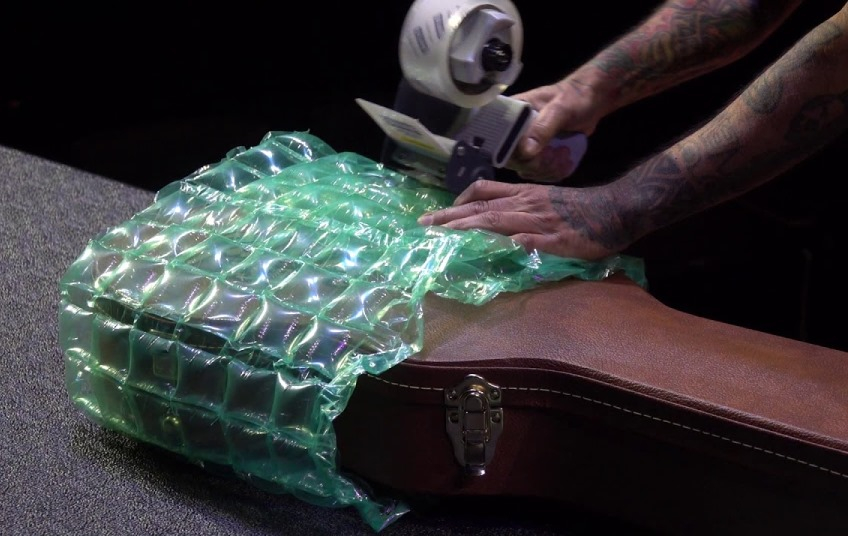Before the advent of online music retail stores, musicians had to drive to their trustworthy music shops in town to spend their hard-earned gigging money on new gear. Talking to the cashier, learning about different guitar brands, and finally picking out a new trusty instrument was part of “the ritual.” Placing it in its appropriate hard-shell case or gig bag and putting it in the car felt like placing a newborn baby in the car on its first ride home from the hospital.
Now, with the advent of online music retail sites like Reverb, Sweetwater, and Musician’s Friend, musicians can have their instruments delivered to their residence at the press of a button. However, this trade-off may come with a huge price such as opening up the box on your front doorstep to find the neck snapped in half! How can modern packaging keep up with protecting vintage gear and keeping the spirit of music alive and in one piece?
Customers with broken gear always pop up in comment sections, forums, and gear reviews on the major music sites around the internet. Most of them may be “flukes” or just got a “dud” but others seem genuinely shocked and concerned that their precious gear was damaged in transit. One anonymous former FedEx sales rep states, “Guitars, amplifiers, and other music related items are not conductive to being shipped in today’s modern parcel delivery networks. Simple as that. Music equipment is fragile.”
He goes on to explain that high speed delivery networks with bustling conveyor belt filled warehouses may be too rough for fragile music equipment. Warehouses like the infamous “Hub” at FedEx work on a tight schedule and cannot afford to “be too careful” with all their packages. Boxes are constantly being bumped, slid, dropped, scanned, and thrown around in order to make operations faster. Workers sometimes fail to recognize the fragility of musical instruments and that they have structural weaknesses.
The most notorious is the neck scarf joint on Gibson Les Paul guitars. This is where the headstock and fretboard meet. Typically, two pieces of wood are joined together by a scarf joint at this point. If the right pressure or force is acted upon this joint, this can cause the headstock to snap off completely.
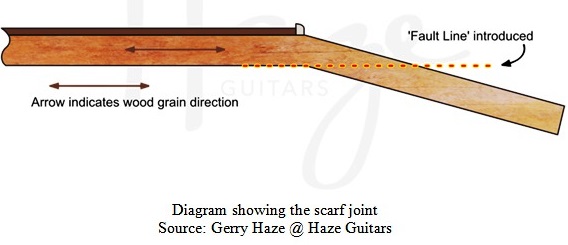
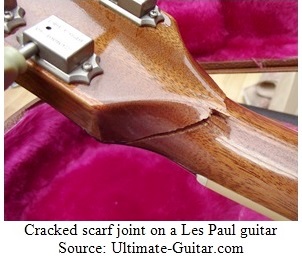
First time music gear sellers are also part of the problem. Guitars, basses, and drums are all made with well treated and tempered woods. However, theses woods are still susceptible to temperature changes and hard impacts. If they are being packed and shipped for delivery, they need to be properly encased either in a high-quality gig bag or hard-shell case. One of the more common “rookie mistakes” by first time sellers is placing the instrument in a square cardboard box surrounded by packaging peanuts or newspapers. Buyers and sellers are always figuring out the art of the deal. Buyers typically do not like to spend extra money on shipping costs and sellers do not want to spend money on getting the instrument properly packaged and ready for shipping. However, in order to ensure that the instrument does not get damaged during transit, it must be properly packaged at the lowest cost possible.
Most sellers recommend first placing the guitar in a hard-shell case and not a gig bag. Certain gig bag materials, like nylon, can be easily torn and pierced by sharp objects. They also do not provide adequate shock protection from impacts or from long term compression. Guitars are also notorious for sliding around inside gig bags. Hard shell cases on the other hand are made out of wood or hard plastic with a plush or velvet interior. This makes it so that the guitar is secured gently but not tightly in place within the case. Reverb.com, a popular online music retail site, recommends wrapping the headstock either in newspaper or bubble wrap as this is the weakest part of the guitar. They also recommend placing the guitar in a hard-shell case being sure to fill in any gaps with either newspaper or bubble wrap. Next, the hard-shell case is placed in a rectangular box which is then packed with more newspaper or bubble wrap. Even with all these precautions in place, accidents still happen.
In 2017, while flying from New York City to Toronto, guitarist Kevin Ramessar opened up his $4000 Stonebridge acoustic guitar case to find his pride and joy had suffered a fatal neck snap near the headstock.
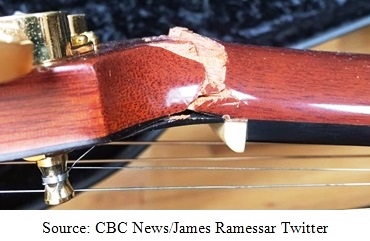
Ramessar had properly placed his guitar into its appropriate hard shell plastic case. The case was printed all over with stickers that said WARNING FRAGILE. The airline released this statement to Ramessar a couple days after the incident:
“We were sorry to learn that your guitar was received in a damaged condition after your travel to Toronto on June 21st, 2017. We can understand how frustrating this experience must have been. Our staff endeavours to handle all our passengers’ baggage carefully, including fragile items, but there are a number of unavoidable factors involved, such as turbulence, shifting of items during takeoff and landing; and no airline can there guarantee against damage.”
Even if all precautions are taken, accidents can still happen. Companies and employees cannot afford to take time and slow down operations just to handle a few guitars. Buyers and sellers will always try to get the best “bang for the buck” to ship or receive their guitar for the lowest price at the cost of protection. This begs the question, “How can packaging technology benefit priceless music gear?”
Music Radar magazine lists the most popular and trustworthy hard-shell cases and gig bags available on the market for guitar players. Among them is the SKB 3i-4214-OP hard-shell case, which is a waterproof, molded plastic case and has a pressure equalization valve. SKB claims that the case is literally “tank proof” and is made of military-grade plastic. The one downside is that the case runs for around $300 on most music retail sites, which may be out of a middle-class musician’s budget.
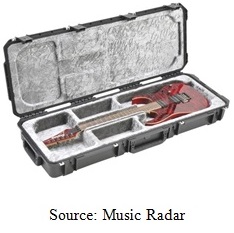
Case manufacturers can work with others to create rugged and “tank proof” guitar cases designed to protect that which all musicians hold dear. If technologies like these become more available on the market, it will likely drive the cost down to where the average musician can afford them for all of his guitars.
References
https://www.cbc.ca/news/canada/kitchener-waterloo/air-canada-broken-guitar-kevin-ramessar-1.4190866
https://www.thegearpage.net/board/index.php?threads/the-truth-about-shipping-guitars-once-and-for-all.1884563/
https://reverb.com/news/how-to-ship-a-guitar
https://www.musicradar.com/news/the-best-guitar-cases-and-gig-bags





























